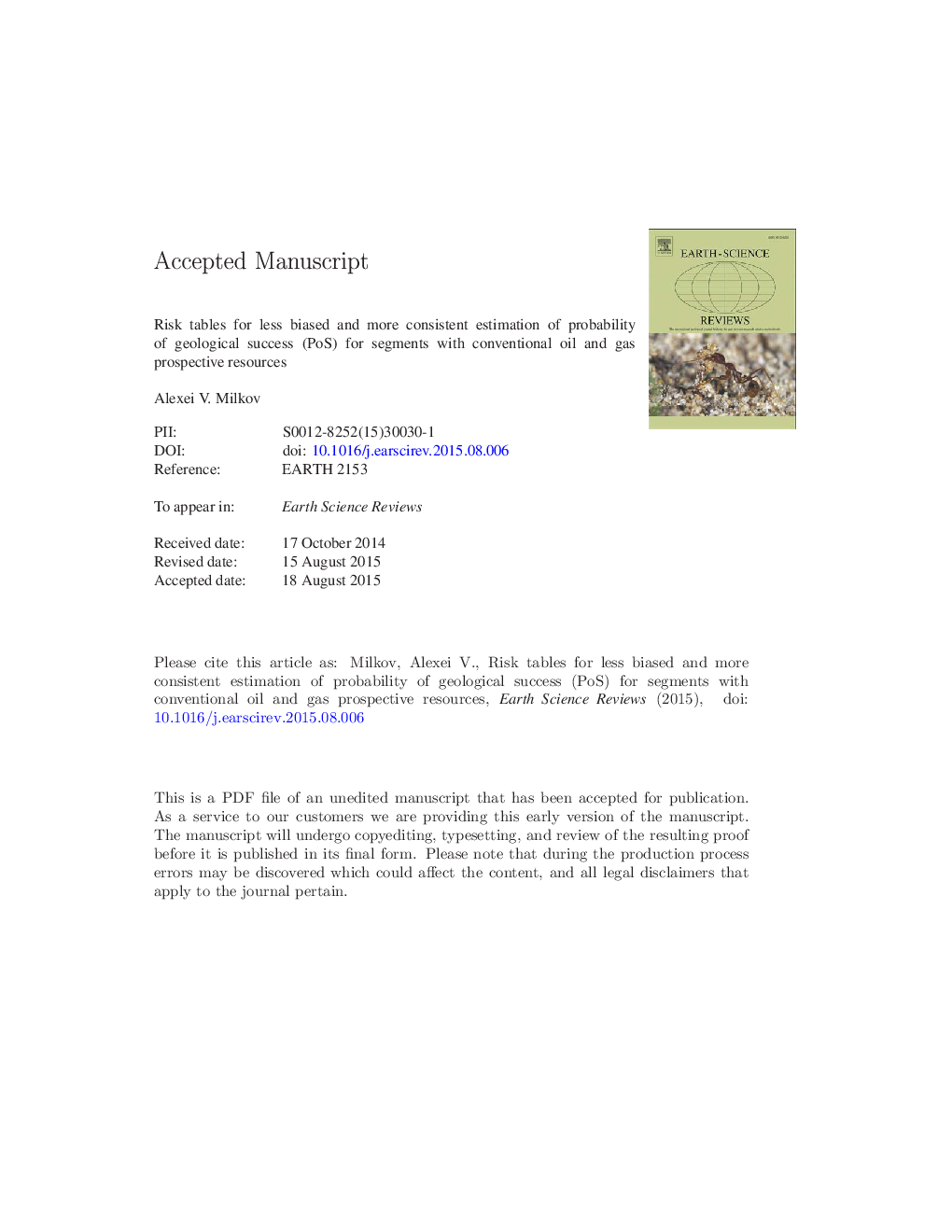| کد مقاله | کد نشریه | سال انتشار | مقاله انگلیسی | نسخه تمام متن |
|---|---|---|---|---|
| 6442919 | 1639952 | 2015 | 107 صفحه PDF | دانلود رایگان |
عنوان انگلیسی مقاله ISI
Risk tables for less biased and more consistent estimation of probability of geological success (PoS) for segments with conventional oil and gas prospective resources
دانلود مقاله + سفارش ترجمه
دانلود مقاله ISI انگلیسی
رایگان برای ایرانیان
کلمات کلیدی
موضوعات مرتبط
مهندسی و علوم پایه
علوم زمین و سیارات
زمین شناسی
پیش نمایش صفحه اول مقاله

چکیده انگلیسی
Oil and gas explorers routinely estimate the probability of success (PoS) of exploration projects, which is used for the calculation of risked prospective resources, their expected monetary value, ranking of the prospects and exploration portfolio management. Most often, the estimation of the geological PoS is based on subjective judgments about probabilities for individual geological risk factors. However, such subjective probabilities are not reliable in the low-validity environments with significant degrees of uncertainty and unpredictability, to which many exploration projects belong. When explorers assign probabilities for risk factors, they are geared by their variably incomplete knowledge and fragmentary experience, use judgmental heuristics under the influence of cognitive and motivational biases, and are prone to logical fallacies (unless they are aware of these limitations and account for them in scientifically responsible ways). As a result, assessments of geological PoS tend to be inconsistent across an exploration company, which leads to biased portfolios that fail to deliver on promise. Recent research and experience from other industries suggest that algorithms are superior to expert judgments in low-validity environments. This paper presents a review of relevant literature on the psychology of decision making and risk assessment methods used in petroleum exploration, and proposes a new algorithm for geological PoS assessment, realized in the form of systematic risk tables for probabilities of six geological risk factors (structure, presence of reservoir facies, reservoir deliverability, seal, source presence and maturity, and migration). The risk tables enable explorers to convert geological information into quantitative probabilities while counteracting the deficiencies of expert judgment and reducing the effects of biases. The risk tables take into account both the data-derived and model-derived positive, negative and neutral evidence for each of the risk factors, utilize the most elementary, fundamental and relevant subsurface information and can be used in a wide variety of exploration projects. The risk tables shift the focus of geological risk assessment from arguing about the probability values to a more objective and consistent evaluation of subsurface data and models. Probabilities are extracted from risk tables in a manner transparent to all involved, including peers, managers and investors. Implementation of the risk tables will allow explorers to dispassionately and consistently put high PoS values on relatively low-risk prospects and low PoS values on relatively high-risk prospects, and would enable managers to make well-informed drilling decisions. The use of risk tables will lead to less biased prospect inventories, effective portfolio management and better long-term exploration performance.
ناشر
Database: Elsevier - ScienceDirect (ساینس دایرکت)
Journal: Earth-Science Reviews - Volume 150, November 2015, Pages 453-476
Journal: Earth-Science Reviews - Volume 150, November 2015, Pages 453-476
نویسندگان
Alexei V. Milkov,